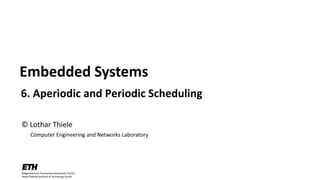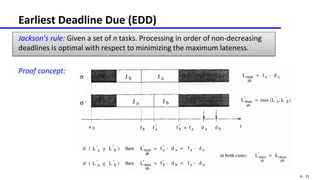This document discusses real-time scheduling of periodic and aperiodic tasks. It introduces key terms like deadline, period, computation time. For periodic tasks, it covers rate monotonic and deadline monotonic scheduling. For aperiodic tasks, it discusses the earliest deadline due, earliest deadline first, and earliest deadline first with precedence constraints algorithms. It provides examples and proofs of optimality for minimizing maximum lateness.





































































![6 - 70
EDF Scheduling
If the deadline was missed at t2 then define t1 as a time before t2 such that (a) the processor is
continuously busy in [t1, t2 ] and (b) the processor only executes tasks that have their arrival
time AND their deadline in [t1, t2 ].
Why does such a time t1 exist? We find such a t1 by starting at t2 and going backwards in time,
always ensuring that the processor only executed tasks that have their deadline before or at t2 :
Because of EDF, the processor will be busy shortly before t2 and it executes on the task that has
deadline at t2.
Suppose that we reach a time such that shortly before the processor works on a task with deadline
after t2 or the processor is idle, then we found t1: We know that there is no execution on a task with
deadline after t2 .
But it could be in principle, that a task that arrived before t1 is executing in [t1, t2 ].
If the processor is idle before t1, then this is clearly not possible due to EDF (the processor is not idle, if
there is a ready task).
If the processor is not idle before t1, this is not possible as well. Due to EDF, the processor will always
work on the task with the closest deadline and therefore, once starting with a task with deadline after t2
all task with deadlines before t2 are finished.](https://image.slidesharecdn.com/6realtimescheduling-230623222953-a7721124/85/6_RealTimeScheduling-pdf-70-320.jpg)














![6 - 85
EDF – Total Bandwidth Server
Schedulability test:
Given a set of n periodic tasks with processor utilization Up and a total bandwidth
server with utilization Us, the whole set is schedulable by EDF if and only if
Proof:
In each interval of time , if Cape is the total execution time demanded by
aperiodic requests arrived at t1 or later and served with deadlines less or equal to
t2, then
1
s
p U
U
]
,
[ 2
1 t
t
s
ape U
t
t
C )
( 1
2
](https://image.slidesharecdn.com/6realtimescheduling-230623222953-a7721124/85/6_RealTimeScheduling-pdf-85-320.jpg)
